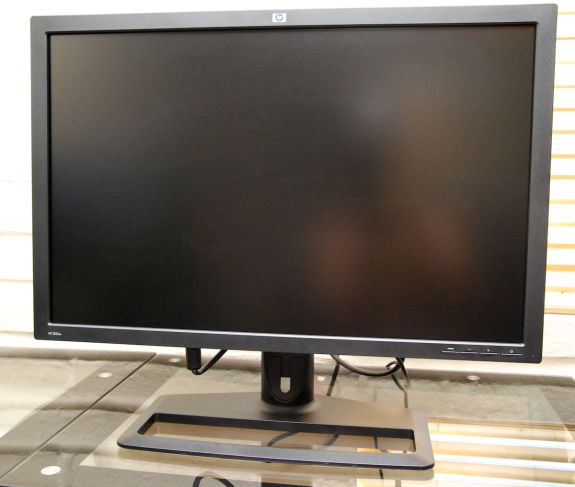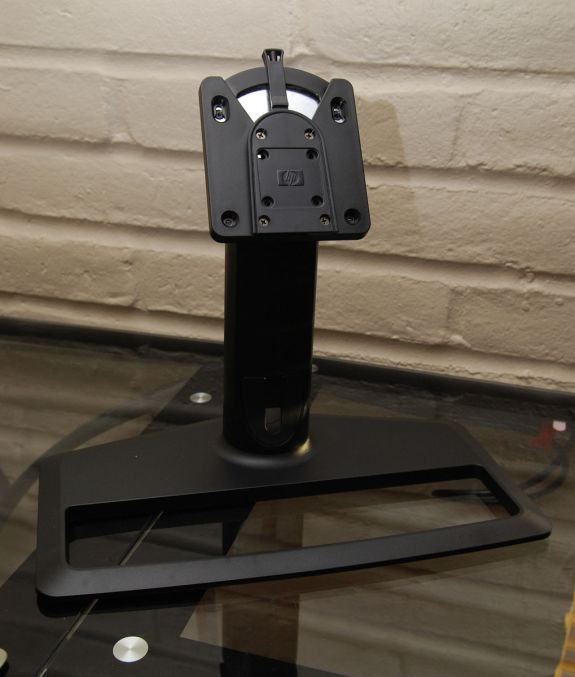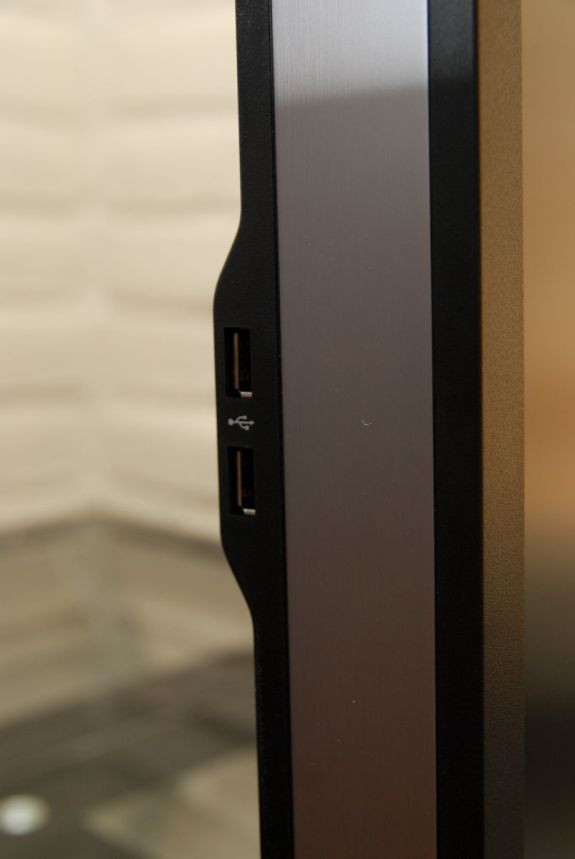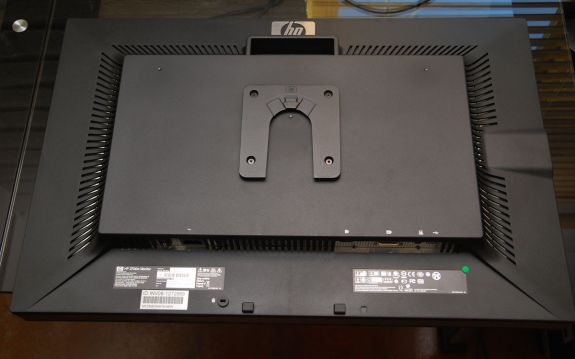A New 30" Contender: HP ZR30w Review
by Brian Klug on June 1, 2010 6:30 PM ESTRight out of the box, HP’s newest 30” display is huge - but you expected that and prepared by already clearing off your desk, right? ;)
Getting the beast of a monitor out of the packaging was actually exceedingly easy; remove one piece of styrofoam, and out comes the stand. One more large piece and the panel is right there for your picking.
The ZR30w display stand packs virtually all the bells and whistles a 30” stand should. There’s 4” of vertical travel, and movement in every axis except pivot (meaning you can’t rotate and use the monitor in portrait mode unless you roll your own VESA stand). HP’s quick release lock system is actually surprisingly useful. The monitor has a slide-in rack which mates up to the display stand; you can slide the monitor in, move a lever into the locked position, and you’re done. This is again the same mechanism used in the LP3065. I was very impressed with how solid and simple this configuration was - there’s no flexing or creaking, and no screws or assembly. It’s always a nice touch when out of box setup is painless - it’s downright critical when you’re juggling a 30” display. In addition, at the base of the monitor is a snap-on cable management cover for routing cables.
Around back is a much larger HP logo, cooling vents, and the display inputs. There’s also a semi hand hold which is great for guiding the monitor into the latch mechanism. Other than that, there’s not much else to speak of except the two USB 2.0 ports on the left of the display. What’s good about the ZR30w’s aesthetics is that they aren’t loud, garish, or overwhelmed with branding.
I noted in previous display reviews that sometimes at the lowest height setting the display connectors can hit the stand or otherwise be obstructed. Note that HP gives almost two entire inches of clearance for cables. This is the way it should be done - no problems connecting DVI cables, especially since dual-link cables are notably beefier.
We always like to use the monitor out of box without calibration for some time and just get a feel for it. While it’s easy to make a case that if you’re shopping for a 30” LCD, you’ve probably got the means to calibrate, it’s a harder case to make on the smaller displays. That said, I was immediately impressed with the ZR30w. Right away, the greens and reds were notably richer than on my two BenQ FP241W displays I use daily.
HP ships its manual on an enclosed CD-ROM, and also part of that installer is a color calibration .icm profile. As a rule, I’m going to start using manufacturer-supplied color profiles for my subjective uncalibrated testing and “uncalibrated” results, since they’re closest to what average users without colorimeters are going to do. Even with this ICM profile however, the panel seemed a bit cool in temperature to me (I later measured and found the same), but everything else seemed quite good.





















95 Comments
View All Comments
B3an - Friday, June 4, 2010 - link
Anyone?Brian Klug - Wednesday, June 9, 2010 - link
It depends on what you mean by colors. For real world color gamut, just compare the gamut to the 3008. I don't think we've tested that one yet.Otherwise, this is a 10 bit per channel monitor, so if you have an aware application you can drive more colors.
fenry - Friday, June 4, 2010 - link
The HP LP3065 had lower power specs! These are the numbers from HP:LP3065 ZR30w
176 185 Max Pwr (Watts)
118 139 Typical Power (Watts)
Maybe they mean it's more efficient when it's OFF (<2 Watts).
How do they get away with this being part of their advertising???
I've been paying careful attention to power draw of large monitors from some time, so I am extremely disappointed at HP for this misleading advertising. Check it out for yourself!
xismo - Friday, June 4, 2010 - link
I'm looking forward to the updated review. And honestly the workstation video cards are not that expensive. It's not like you need to get the Quadro FX 5800 to test 10-bit support in photoshop or maya. Like I mentioned earlier almost all of the workstation video cards have native 10-bit support so getting a Quadro FX1800 will actually cost you less or the same as 5870. Also ATI Firepro are generally cheaper and are just as good. NVIDIA hasn't updated their workstation cards for a while, while ATI released one just recently. But obviously if you'd like to get $3000+ high end card like the 5800 I can't stop you :)ProDigit - Saturday, June 5, 2010 - link
I don't care if it's a big screen, I just don't find a lot of justifying a screen that consumes about as much as my common desktop (The EeeBox for instance consumes roughly 20-25W, this screen 150-180W).Personally they would have done better with a LED backlit screen!
The price is also too much!
The last monitor you reviewed was a $300 26" screen, this one is only 4" larger diagonally, and boosts the 1080p resolution to 1600p, but still no reason to be almost $1k more!
Sorry to say, but this monitor is not a good buy; and unless you're busy professionally, you're better off buying 4x $300 26" monitors instead!
jiulemoigt - Sunday, June 6, 2010 - link
Considering even though they are only 10-12 bit displays I would have expected that any monitor claiming to have good color accuracy would be compared to the LCD3090W-BK-SV or LCD3090WQXi-BK.doclucas - Monday, June 7, 2010 - link
HP claim that there is no IC available for 30" is plain bullshit! There are many 30" that come with excellent OSD, such as my Dell 3008WFP (I also own HP LP3065 which I don't like compared to the Dell). Dell still make the best quality (affordable/mainstream) monitors, period.Gilbo - Tuesday, June 8, 2010 - link
Those monitors can implement OSD because they also have scalers.Scalers for 30" monitors have high input lag unfortunately, which makes them less desirable for some people.
CannibalisticH0b0 - Monday, June 14, 2010 - link
My main problem with this review is the inconsistent competitors used for comparison in the tests. The main thing I wanted to compare with other 30" monitors was input lag... yet no 30" monitors were compared with the new HP on that page. I agree that the figure looks low, but it would be nice to have that same exact test done (and shown) with the Dell 3007WFP, for example, which I believe is/was still the king of 30" monitors for gaming.mcklevin - Wednesday, June 16, 2010 - link
I would like to see how this fares against the apple cinema display. I recently purchased and returned the LG 3000H-BN because of a signal defect. However when it did work, I did notice that the anti-glare screen coat was highly distracting at the corners and off angle on a dark screen, especially in a dark room. Is it the same way with this display? In a lit room is a black screen noticeably gray?